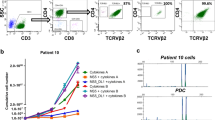Summary
A continuous cell line, Se-Ax, from a patient with Sézary syndrome has been established. The Se-Ax cell line is IL-2 dependent, requires human serum for permanent growth, and has the following phenotype: CD1-, CD2+, CD3+, CD4-, CD5-, CD8-, CD20-, CD25+; it expresses the T9, T10, and HLA-DR antigens. This cell line reveals multiple chromosome aberrations as seen in the most abundant abnormal clone in peripheral blood. Therefore, it is not unlikely that it derives from tumor cells. A putative cytotoxic cell line derived from the same patient has only weak killer-cell activity against the autologous permanent cell line: this CD8+ cytotoxic cell line has a 14q+ chromosomal marker. The fact that the patient demonstrated no natural killer-cell or activated killer-cell activity against the Se-Ax cell line may in part explain the successful establishment of the continuous cell line from bulk culture.
Similar content being viewed by others
References
Chen TR (1977) In situ detection of mycoplasma contamination in cell cultures by fluorescent Hoechst 33258 stain. Exp Cell Res 104:255–262
Gazdar AJ, Carney DN, Bunn PA, Russell EK, Jaffe ES, Schechter GP, Guccion JG (1980) Mitogen requirements for the in vitro propagation of cutaneous T-cell lymphomas. Blood 55:409–417
Goldstein MM, Farnarier-Seidel C, Daubney, Kaplanski P (1986) An OKT4+ T-cell population in Sézary syndrome: attempts to elucidate its lack of proliferative capacity and its suppressive effect. Scand J Immunol 23:53–64
Grimm EA, Ramsey KM, Mazumder A, Wilson DJ, Djeu, JY, Rosenberg SA (1983) Lymphokine-activated killer cell phenomenon. J Exp Med 157:884–897
Hecht F, Morgan R, Hecht BK, Smith SD (1984) Common region on chromosome 14 in T-cell leukemia and lymphoma. Science 226:1445–1447
Kaltoft K, Thestrup-Pedersen K, Jensen JR, Bisballe S, Zachariae H (1984) Establishment of T and B cell lines from patients with mycosis fungoides. Br J Dermat 111:303–308
Kaltoft K, Bisballe S, Rasmussen K (1985) Balanced terminal chromosome translocations develop in EBV-derived, but non immortal cell lines from patients with mycosis fungoides. Acta Derm Venereol (Stockh) [Suppl] 120:60–67
Lozzio CB, Lozzio BB (1975) Human chronic myelogenous leukemia cell line with positive Philadelphia chromosome. Blood 45:321–334
Palker TJ, Scearce RM, Miller SE, Popovic M, Bolognosi DN, Gallo RC, Haynes BF (1984) Monoclonal antibodies against human T-cell leukemia-lymphoma virus (HTLV) p24 internal core protein. J Exp Med 159:1117–1131
Poiesz BJ, Ruscetti FW, Reitz MS, Kalyanaraman VS, Gallo RC (1981) Isolation of a new type-C retrovirus (HTLV) in primary uncultured cells of a patient with Sézary T-cell leukemia. Nature 294:268–271
Reedman BM, Klein G (1973) Cellular localization of an Epstein-Barr virus (EBV)-associated complement-fixing antigen in producer and non-producer lymphoblastoid cell lines. Int J Cancer 11:499–520
Robert-Guroff M, Ruscetti FW, Posner LC, Poiesz BJ, Gallo RC (1981) Detection of the human T-cell lymphoma virus p19 in cells of some patients with cutaneous T cell lymphoma and leukemia using a monoclonal antibody. J Exp Med 154:1957–1964
Sandberg AA (1980) The chromosomes of human cancer and leukemia. Elsevier, North-Holland, Amsterdam
Shah-Reddy I, Mayeda K, Mirchandani I, Koppitich BS (1982) Sézary syndrome with a 14:14 (q12:q31) translocation. Cancer 49:75–79
Slater D, Bluhen S, Rooney N, Hamed A (1983) Type C retrovirus-like particles in mycosis fungoides. Br J Dermatol 109:120–125
Van der Loo EM, van Muijen GNP, von Vloten WA, Beens W, Scheffer E, Meijer CJLM (1979) C-type virus-like particles specifically localized in Langerhans and related cells of the skin and lymph nodes of patients with mycosis fungoides and Sézary's syndrome. Virchows Arch [Cell Pathol] 31:193–203
Weiss R, Teich N, Varmus H, Coffin J (eds) (1985) RNA tumor viruses, 2nd suppl, p 423. Cold Spring Harbour Laboratory
Wong-Staal F, Hahn B, Manzari V, Colombini S, Franchini, G, Gelmann EP, Gallo RC (1983) A survey of human leukemias for sequences of a human retrovirus. Nature 302:626–628
Author information
Authors and Affiliations
Rights and permissions
About this article
Cite this article
Kaltoft, K., Bisballe, S., Rasmussen, H.F. et al. A continuous T-cell line from a patient with Sézary syndrome. Arch Dermatol Res 279, 293–298 (1987). https://doi.org/10.1007/BF00431220
Received:
Issue Date:
DOI: https://doi.org/10.1007/BF00431220




